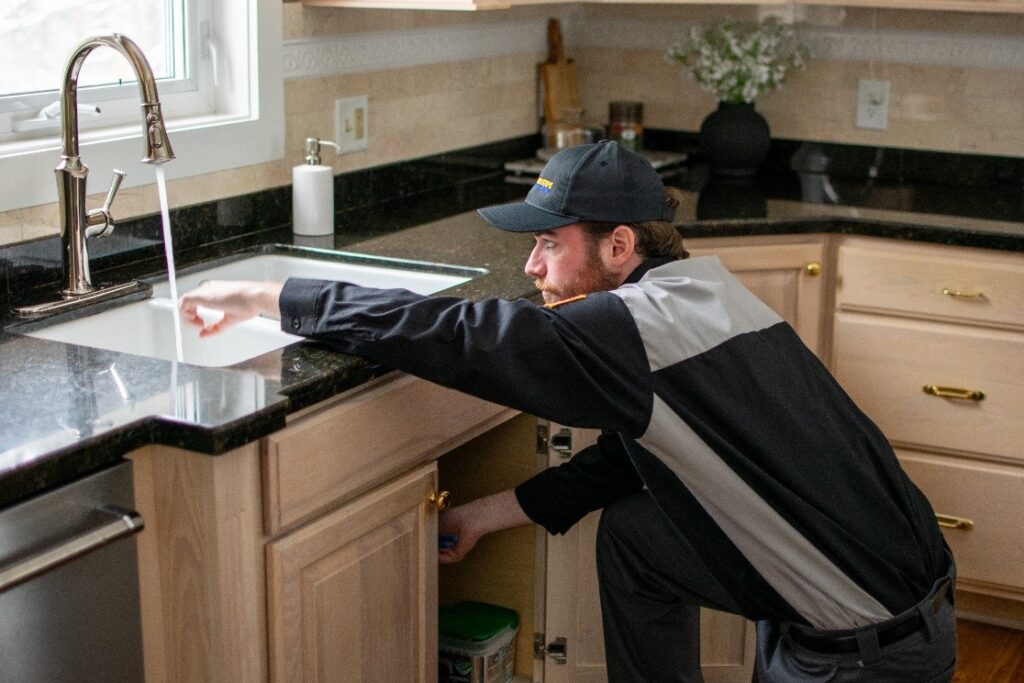
Are you preparing for the winter season? If so, then you need to ensure that your house’s plumbing is properly prepared as well. In this article, we will discuss the top most common winter plumbing problems, as well as how to resolve them quickly and effectively.
Some of the most common winterizing plumbing problems include frozen pipes, leaks and clogs, and damaged sewer lines. While these can be frustrating and sometimes difficult to fix, there are a number of simple methods you can try to get them back in good working order.
Best Ways to Prevent Frozen Pipes
One effective way to prevent frozen pipes is by insulating exposed pipes, as well as any exposed outdoor faucets. You can also try running a slow trickle of water through your pipes to help keep them from freezing.
If you happen to experience a leak or clog, you can try using a plunger or drain snake to clear the blockage and restore proper flow. Additionally, it is important to replace or repair any damaged or worn-out pipes, as these can cause serious issues in the long run.
So, if you are experiencing any winterizing plumbing problems this season, don’t worry – there are simple and effective solutions that will help you get back to normal in no time. Stay warm and stay safe!
Top Most Winter Plumbing Problems
Whether you live in a cold climate or just experience frigid temperatures during the winter months, it’s important to make sure your plumbing is properly winterized. This will help protect your home from common winterizing plumbing problems like freezing pipes, leaks, and clogged drains.
Here are some of the top issues you should be on the lookout for as winter approaches:
- Freezing Pipes: If you have exposed plumbing in areas that are likely to get cold, such as your basement or crawl space, it’s important to take steps to prevent frozen pipes. This can be done by insulating your pipes and using a draft stopper on doors leading outside.
- Clogged Drains: Clogged drains are a common issue during the winter months, as ice and snow can build up in your gutters and drainpipes, leading to slow or blocked water flow. To prevent clogs from occurring, make sure you clean your gutters regularly and use a de-icing agent on any frozen pipes or drains.
- Leaks and Bursts: Another common winter plumbing problem is leaks and bursts, which can occur if your pipes get too cold or freeze over. To prevent this from happening, take steps like wrapping your pipes in insulation and leaving your faucets dripping a little bit to keep the water moving.
Whether you are dealing with minor issues like drips and clogs, or major problems like leaks and bursts, it is important to take proactive steps to winterize your plumbing. By taking these simple steps, you can help keep your home safe and protected all winter long.
Best Ways to Deal with Winter Plumbing Problems
Winter is a challenging time for your home’s plumbing system, as the cold weather can cause a number of issues and problems. Whether you are dealing with frozen pipes, clogged drains, or leaks, it is important to know how to address these common winterizing plumbing problems in order to keep your home running smoothly.
- First: One of the most common winterizing plumbing issues is frozen pipes. This typically happens when water in your pipes freezes and expands, causing the pipes to crack or burst. To prevent your pipes from freezing, it is important to ensure that they are well-insulated and properly sealed. You can also try leaving faucets open a tiny bit or running hot water through your pipes to prevent freezing.
- Second: Another common winterizing plumbing problem is clogged drains, which can be caused by ice, built-up sediment, or even hair and other debris. To prevent your drains from clogging, it is important to regularly clean them out with a drain cleaner or snaking tool. Additionally, you should avoid pouring grease down your drain as this can also contribute to clogs.
- Third: Finally, leaks are another common issue that can affect your plumbing system during the winter months. To deal with leaks, you should first identify where they are coming from and then take steps to repair them or prevent further damage. This may involve checking for cracks in your pipes, sealing any gaps around outdoor faucets, or checking the insulation around your pipes.
Whether you are dealing with frozen pipes, clogged drains, or winterizing plumbing issues, it is important to know how to properly and effectively address these common plumbing issues. By taking steps to prevent and mitigate these problems, you can help keep your home running smoothly no matter what the weather brings.
How to Prepare Your House Plumbing for the Cold Months?
As winter approaches, it is important to take steps to prepare your house’s plumbing for the cold months ahead. This involves taking steps to prevent common issues like frozen pipes, clogged drains, and leaks, as well as addressing any existing problems in order to keep your home running smoothly.
One of the key things you can do to prepare your plumbing for the winter is to ensure that your pipes are well-insulated and properly sealed. This can be done by checking for any cracks in your pipes, sealing any gaps around outdoor faucets, or checking the insulation around your pipes to make sure it is up to snuff.
In addition to insulating and sealing your pipes, it is also important to keep your drains clean and clear. This can be done by regularly cleaning them out with a drain cleaner or snaking tool, as well as avoiding pouring grease down the drain since this can contribute to clogs.
Finally, if you are already dealing with issues like leaks or other problems in your plumbing system, it is important to take steps to address them as soon as possible. This may involve checking for cracks in your pipes, sealing any gaps or leaks around outdoor faucets, or checking the insulation around your pipes to make sure it is adequate.
With proper preparation and maintenance, you can help ensure that your house plumbing will be ready to handle whatever the winter brings.
Read also: Frozen Pipes Aren’t Fun: 4 Winter Plumbing Problems to Look Out For
Conclusion
Whether you’re preparing for a long winter or just looking to save money on energy bills, winterizing your house plumbing is an important step to take. To get started, be sure to check all of your pipes and fixtures for leaks or drips, and fix any problems you find. In addition, wrap exposed pipes with insulation to help keep them warm and prevent freezing. Finally, inspect your water heater and make sure it’s properly winterized so you can stay comfortable all season long. With these tips in mind, you’ll be well prepared for the chilly weather ahead!








